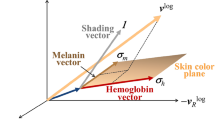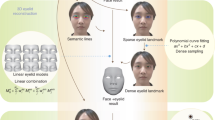Abstract
An electronic medical record (EMR) system was introduced to the University of Miyazaki Hospital, in Japan, in 2006. This hospital is the only one in Japan to store digital photographs of patients within EMRs. In this paper, we report on the utility of these digital photographs for disease diagnosis. Digital photographs of patients were taken at the time of hospitalization, and have been used for patient identification by medical staff. More than 20,000 digital photographs have been saved, along with examination data and medical history classified by disease, since the introduction of EMR. In the first part of the present study, we analyzed the facial cheek color of patients using photographs taken at the time of hospitalization in relation to diagnoses in six disease categories that were considered to lead to characteristic facial skin characteristics. We verified the presence or absence of a characteristic color for each disease category. Next, we focused on four diseases, Analysis of the facial skin color of 1268 patients found the same patterns of characteristic color. Overall, we found significant differences in complexion according to disease type, based on the analysis of color from digital photos and other EMR information. We propose that color analysis data should become an additional item of information stored in EMRs.






Similar content being viewed by others
References
Jha, A. K., et al., Use of electronic health records in U.S. Hospitals. N. Engl. J. Med. 360:1628–1638, 2009.
Tortora, G. J., and Derrickson, B., Principles of anatomy and physiology. Maruzen, Tokyo, pp. 150–176, 2007.
Kidokoro, N., Ishigaki health and welfare center. Resident Note 12(1):52–60, 2010.
Inoue, T., Fujii, Y., Ito, K., Ichioka, Y., Method of multidimensional analysis of minor factors and independent components. Japan Optics ‘95, Extended abstracts, 105–106, 1995.
Hiraoka, M., Firbank, M., Essenpreis, M., Cope, M., Arridge, S. R., Zee, P. V. D., and Delpy, D. T., A Monte Carlo investigation of optical path length in homogeneous tissue and its application to near-infrared spectroscopy. Phys. Med. Biol. 38:1859–1876, 1993.
Tsumura, N., Haneishi, H., and Miyake, Y., Independent component analysis of skin color image. J. Opt. Soc. Am. A 16:2169–2176, 1999.
Tsumura, N., Haneishi, H., Miyake, M., and Kawabchi, M., Mapping pigmentation in human skin by multivisible-spectral imaging by inverse optical scattering technique. J. Imag. Sci. Tech. 45:444–450, 2001.
Software for white skin analysis CM-SA, Konica Minolta Co. Ltd., Tokyo, Japan, http://www.konicaminolta.jp/instruments/products/color/cm-sa/index.html/Accessed 19 August 2011
Kirik Camera Type:H04 Kiriku Co. Ltd., Sinjuku,Tokyo, Japan, http://www.kirik.jp/cam/index.html/Accessed 19 August 2011
Umano M. Osaka Prefecture University, Viva Computer http://www.feelimage.jp/analyzer/productinfo_2.htm/Accessed 19 August 2011
Okamura, R., Okamura Dermatology Clinic, Booklet Derma No. 161, 1–6, 2010.
Kato, Y., Endocrinogloical test. Diencephalohypophysial lipotropin (LPH) and melanocyte-stimulating hormone (MSH). Nippon Rinsho (Jap. J. Clin. Med.) 68:234–236, 2010.
Nishiuchi, N., Tokyo Metropolitan University Health monitoring system for workers using facial image. J. Soc. Occup. Safety Health Ergon. 11:21–27, 2009.
Acknowledgments
The authors thank the patients who participated in this study and the staff of Miyazaki University Hospital for their sincere cooperation in making study possible.
Author information
Authors and Affiliations
Corresponding author
Rights and permissions
About this article
Cite this article
Kawano, K., Suzuki, M. & Araki, K. Use of Digital Patient Photographs and Electronic Medical Record Data as Diagnostic Tools in Japan. J Med Syst 36, 3321–3326 (2012). https://doi.org/10.1007/s10916-012-9824-4
Received:
Accepted:
Published:
Issue Date:
DOI: https://doi.org/10.1007/s10916-012-9824-4




